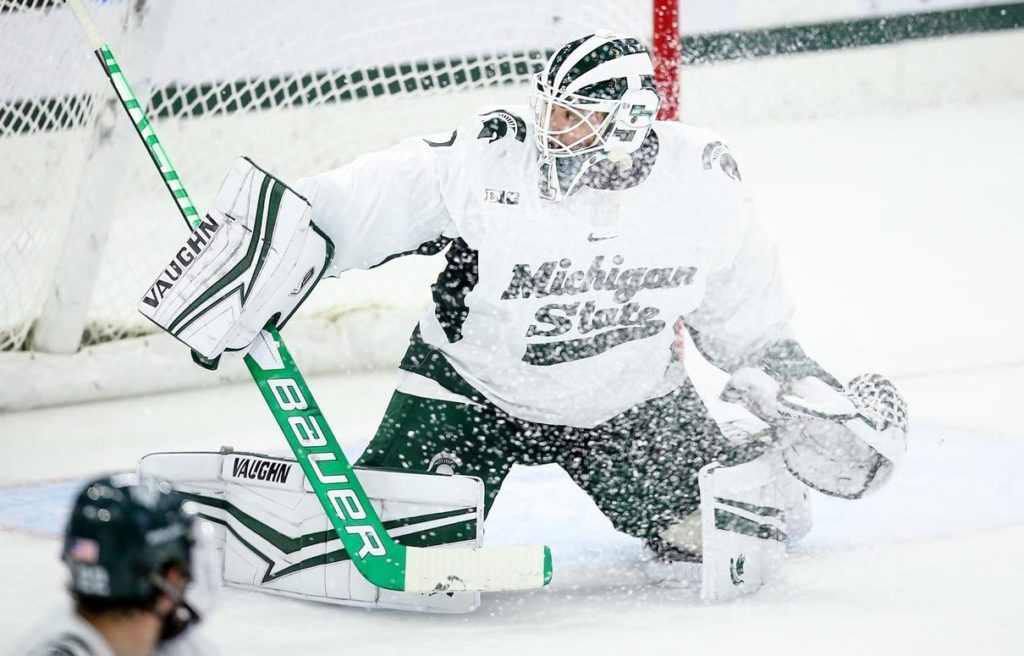
USCHO.com Big Ten columnists Paula C. Weston and Drew Claussen discuss what transpired over the first “half” of the 2020-21 season, and also prognosticate what to expect once play resumes after the holidays.
Drew: Well, Paula, it is finally time to say goodbye to the year that was 2020. My wife and I welcomed our first child into the world this year (14 days into it, way back in January) and bought a new home this summer, but other than that, I think I speak for both us in hoping that next year tosses out a few more positive events and that the phrase “social distancing” becomes something for the history books sooner rather than later.
From a hockey perspective, COVID-19 meant the cancellation of the Big Ten and NCAA Tournaments last March and cast a shade of doubt on if there would be a 2020-21 season. Eventually we got a schedule and Wisconsin got things started by shutting out Notre Dame Nov 13.
This obviously has been the weirdest first half of any college hockey season. Saying that we are in unprecedented times has quickly become a cliché, but it’s hard to describe a scenario where masks are mandatory, stands are empty and the Big Ten has a dedicated nonconference team that’s playing an all-road game schedule any differently.
Jumping straight into conference play was a struggle for most teams, as five of the seven teams have losing conference records at the break. Minnesota has been the belle of the ball, starting the season with an 8-0 record and vaulting to the top of the national polls. Wisconsin and Michigan have shown flashes of being great teams, too, and should regain form when they get their full squad back.
I think this conference has enough history to show that it isn’t wise to call a title race at the holiday break and that we’re bound to see some movement in the second half. What are your thoughts so far?
Paula: There are so many things to take away from this early part of the Big Ten schedule that it’s difficult to know where to start. The main thing that impresses me isn’t related to performance on the ice but rather how the conference pulled off a relatively successful start to the season in spite of the pandemic.
As I told Jimmy Connelly in this week’s TMQ, I was very skeptical going into the hockey season overall but especially so regarding the Big Ten. I saw the mistakes that both Michigan State University and the University of Michigan made regarding COVID-19 early in their semesters – I live an hour away from each – and I was worried about what I saw with the Wisconsin football program, too.
As someone who works in higher education as well, I knew how difficult it had already been to manage campuses and student populations during the global pandemic. I feared that the at best the B1G hockey schedule would be significantly disrupted and at worst that many people associated with hockey programs would be infected.
That the Big Ten pulled off its condensed schedule with minimal disruptions is a remarkable feat – especially since teams were traveling.
The quality of hockey that we saw, too, was impressive. As you pointed out, the start of the hockey season was rough for several teams. Some were still trying to adjust to the realities of fragmented practices and team-building via Zoom. Some clearly missed the warm-up of exhibition games and early season nonconference play.
One team that seemingly avoided all of that is Minnesota. I’m sure that Bob Motzko would argue that the Golden Gophers’ start wasn’t executed flawlessly, but the win column is all that counts heading into the remainder of the season.
I keep going back to a couple of things that Motzko has said since the start of the pandemic. The first was back in March, when he said that he couldn’t contemplate that we’d be without hockey this season, that there were enough smart people in the world to make hockey happen. The second came at the start of this season, though, when Motzko said that teams that managed the pandemic the best would prevail.
It looks to me that managing the pandemic well in Minnesota includes beginning the 2020-21 season where the Golden Gophers left off eight months ago. What do you see contributing to Minnesota’s success?
Drew: It sounds over-simplified, but in my opinion the Gophers are a great example of a team that took their bumps and bruises and were allowed to grow.
This is Motzko’s third season behind the bench in Minneapolis. In 2018-19, he had eight freshmen and last year, he had 11. This year, there are only three newcomers, and it shows. I still can’t get over the fact that the Gophers haven’t trailed this season and have forced opponents to go 0-17 on the power play. That’s simply amazing.
I think this may be the type of Minnesota team we can get used to as Motzko is allowed to bring in more recruiting classes. Are the Gophers going to regularly rack up eight-game winning streaks? Probably not, but you look at a player like Ben Meyers, who’s tied for the team lead in points and who spent two full seasons in the USHL, and that bodes well for the future. The Gophers are still going to get their highly touted players that stay for a year or two and then bolt for the pros, but Motzko found success at St. Cloud State with players like Meyers and there’s no reason to think he can’t continue to do that same at Minnesota.
Finally, and this is the definition of burying the lede, there’s Jack LaFontaine, also known as the only goaltender to show up on Minnesota’s stat sheet. Motzko has admitted that he didn’t plan to start LaFontaine in all eight games, but with the senior putting up a 1.00 GAA, how can you not? His story going from Michigan to the BCHL to Minnesota is truly amazing and it’s wonderful to see him find success.
So, Minnesota’s the obvious story of the first half but who can give the Gophers a run for their money in the second half?
Paula: The two teams that come to mind are Wisconsin and Michigan, but each needs to finish the season very differently from the way it began. The Badgers and the Wolverines are both insanely talented, but each heads into the break with a .500 record. Of course, not all break-even records are created equally.
Last season, Wisconsin welcomed a talented freshman class that brought great expectations in Madison, especially after the Badgers’ explosive start to 2019-20. A last-place Big Ten finish was the last thing they expected, but that ending point is where they started from this season.
So far, the Badgers have shown significant improvement defensively, although Wisconsin’s total team defense needs to play more consistently to contend for a B1G title. There are still questions about Wisconsin’s goaltending, too, with senior Robbie Beydoun – a transfer from Michigan Tech and a steady presence – having played most of the minutes for the Badgers, but freshman Cameron Rowe has shown promise.
The Wolverines also have a consistency issue, but it’s related more to welcoming a big freshman class, one at least as highly touted as last year’s Badger newcomers and one that has made an immediate impact on Michigan’s offense. A freshman foursome leads Michigan in scoring – Thomas Bordeleau, Kent Johnson, Brendan Brisson, Matty Beniers – and rookie defenseman Owen Power cannot be ignored.
Junior Strauss Mann is playing well and there is good senior leadership on this team. Mel Pearson seems very confident in where his team will end up by the end of the season, and why not? The Wolverines have a knack for pulling off a good second half, and this team looks fast, fun, and skilled.
Do you see anyone challenging Minnesota? Is it too early to define these three teams as the top tier of the Big Ten? And where does that leave everyone else?
Drew: Stranger things have happened, but I’m not rushing to the closest sportsbook to bet against Minnesota. It is food for thought, though, to remember that the Gophers have won the Big Ten regular season four times but have only won the tournament once.
So, the second half should still have its fair share of intrigue. I do think Michigan and Wisconsin make up a tier closely behind the Gophers at this point, but both of those teams look very dangerous when they’re at full strength.
Ohio State and Notre Dame strike me as two similar teams, in that I think they could catch fire if they can find some opportunistic scoring to go along with solid goaltending. Tommy Nappier has shown he’s more than up to the task in the past for the Buckeyes and the tandem of Dylan St. Cyr and Ryan Bischel have both shown flashes for the Irish. Both teams usually play solid defense, so lighting the lamp consistently seems to be the final piece of the puzzle.
The Big Ten tournament this year is another X factor. No format has been announced yet, but with only three days set aside for it I assume it will be a single-elimination tournament at a neutral site like the “old days.” So even if it’s a three-horse race at the top, Ohio State, Notre Dame, Penn State and Michigan State can still do themselves a huge favor by finishing as far up the conference standings as possible. Remember, last-place Penn State upset Michigan and was close to beating eventual-champion Wisconsin at the first tournament in 2014.
Well, I think we’ve touched on the main storylines of the first half. Any final thoughts? First half MVP? (I’d probably go with LaFontaine), Series you’re looking forward to in 2021?
Paula: It’s hard to argue against LaFontaine, who’s playing the best hockey of his life right now. If Minnesota continues to perform through the remainder of the season, he’ll be a big part of the engine that drives the Gophers and will be courting Big Ten Player of the Year honors.
As for series I’m most looking forward to, there are two matches at the very end of the calendar that I’m really anticipating, Michigan’s series at Minnesota followed by a single game between the Wolverines and the Spartans in East Lansing to end the season. The reasons for the first are obvious: Minnesota swept Michigan at Yost in the first part of the season and by the time they meet in that final series, there is a possibility that the regular-season title could be on the line.
That final game in East Lansing is intriguing for more than just the heated rivalry between those teams. Michigan State is a competitive team that doesn’t get enough notice. In fact, the Spartans have the second-highest PairWise ranking among Big Ten teams – which, granted, isn’t saying much, as they’re at No. 20 and Minnesota is No. 2.
But look at what they did against Notre Dame this past weekend, a tie in which Notre Dame took the extra shootout point and an overtime win. They’ve been outscored by a narrow margin (18-16), their defense is tied for 12th nationally with Massachusetts and junior Drew DeRidder is having a solid start between the pipes. You mentioned what may happen if Ohio State and Notre Dame get hot offensively, but I think the sleeper team is Michigan State. If the Spartans get some scoring while keeping their defense this tight, they will climb right up the standings. That may make what happens in that final game of the season very interesting indeed.
You also mentioned the Big Ten tournament and its three-day format, and I’m eager to see the league announce something about that. I’m eager to see Michigan’s team develop and Wisconsin’s team continue to mature. I’m eager to see how Penn State – who ended this first bit so hot – will fare after the first of the year.
Mostly, though, I’m just eager to see some good hockey in the coming months with limited interruptions and no serious COVID-related developments. Everything is so uncertain. All we can do is roll with it.
Here’s to some great hockey in 2021. Here’s to a great new year to you and your lovely family, Drew. And here’s to every bit of health and happiness to everyone throughout the Big Ten and to the greater college hockey community.


